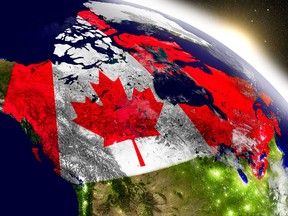Donald Trump’s trade war could push businesses to find new markets, but not without cost
Article content
Kyle Feigenbaum planned to take things slowly after meeting with an Asian retailer a few months ago to explore Hong Kong, Singapore and Malaysia as markets for his Montreal-based dog food company. But the tariff battle between the United States and Canada ignited by U.S. President Donald Trump over the weekend changed that.
Article content
Article content
Feigenbaum instead jumped on the phone Monday to “accelerate” talks about getting his company’s products into markets outside North America.
Advertisement 2
Article content
“It’s crazy to recognize how quickly government actions, warranted and strategic or not, can deeply affect our business,” he said. “Lots of entrepreneurs in my circles are feeling the pressure and looking for solutions.”
Feigenbaum’s business, Healthybud, distributes products through more than 1,200 online and bricks and mortar retailers in North America including Global Pet Foods and manufactures products in both Canada and the U.S. But it wasn’t just smaller companies like his that were feeling nervous nervous as tensions increased with Canada’s largest trading partner this week.
Look beyond CUSMA
William Pellerin, a partner at law firm McMillan LLP who specializes in international trade, fielded call after call from clients Monday looking for ways to offset the impact of the 25 per cent tariffs declared by the Trump administration and the first volley of counter-tariffs imposed by Canada, which were expected to go into effect Tuesday before a late-afternoon reprieve on Monday extended the deadline by 30 days.
His advice was to urge companies to look beyond the Canada-United States-Mexico Agreement (CUSMA) and take fuller advantage of deals such as the Canada-European Union Comprehensive Economic and Trade Agreement (CETA) and the trans-Pacific trade pact, which the United Kingdom signed onto in December.
Article content
Advertisement 3
Article content
“Our exports to a number of markets are too low, frankly, for the size of our economy, and we have been for a long time overly dependent on the United States,” Pellerin said. “So we ought to be looking to the EU and to Asia more than we always have.”
That will be easier for some sectors and companies than others, he said, adding that one area ripe for increased trade outside North America is agricultural commodities such as grains and canola.
“We’re seeing indications there where China’s very interested in taking away some of that traditional relationship space between Canada and the United States, so they may be increased buyers,” he said.
However, differences in consumer profiles mean that not everything is transferable from one market to another.
“Higher-end consumer-type products that we ship, luxury furniture, for example, is not going to get purchased by the Chinese consumer,” Pellerin said. “So it very much depends by industry, by sector.”
Supply management snags
Gaining traction for some increased trade would require rethinking long-held views on supply management, he said, and making concessions.
Advertisement 4
Article content
“If we want to export more dairy-type products, for example, to the EU, or … goods that are currently caught by supply management, such as poultry, then that means that we have to also open our markets so there’s always quid pro quo there,” Pellerin said. “And it’s not clear that there’s necessarily an easy answer, at least with respect to the EU.”
Clifford Sosnow, a partner and chair of the international trade and investment group at law firm Fasken Martineau DuMoulin LLP, said the integration of markets and supply chains within North America have emerged not just out of the close political relationship but also because of proximity and cultural connections that keep friction and costs down. And that will challenge any attempts to diversify or otherwise move away from it, and make it less worthwhile if the tariff dispute proves to be short-lived.
Trade ties that bind

“The reality is that the economies between the United States and Canada have, for decades, developed a very, very integrated space, and it has been supply chains of less friction (and) lower cost, given that so many U.S. companies have affiliates in Canada,” Sosnow said.
Advertisement 5
Article content
Pivoting to other global trading partners is only likely to make sense if the cost of inaction puts a company at risk of failing, he said.
“The question becomes, ‘What is the pain point for Canadians doing business in the United States or importing product from the United States? And does that pain point put our company in peril?’ If the answer is, ‘yes,’ there becomes a crisis element that requires them to look at other agreements,” Sosnow said.
Consumers may have the luxury to take an anti-American stance or switch to Canadian products as suggested by Prime Minister Justin Trudeau in response to the tariffs, but businesses are very unlikely to act on emotion, Sosnow said.
“They may be angry, but they’re also looking at their spreadsheets. They’re looking at their budgets. They’re looking at their obligations, their purchase orders, their survivability,” he said. “And if they look for other supply chains and look to de-risk those supply chains, it will take time, and time is cost.”
Breaking agreements with existing trade partners may not come without cost and other potential challenges, too, he added.
Advertisement 6
Article content
Global supply chain disruptions caused by the COVID-19 pandemic in 2020 forced many companies to re-evaluate where they buy and sell supplies and how much redundancy to build into their systems. Those that did so may be less vulnerable to the trade war, said Sabrina Bandali, a partner in the international trade and investment group at Bennett Jones LLP.
“Those companies will have evaluated their options and can execute on those contingency plans now,” she said.
It will be an uphill battle, however, for those that are looking at this for the first time.
“How readily companies can access these opportunities will differ,” she said. “There will be existing supply and customer relationships in those markets that new Canadian entrants will be disrupting, which is difficult to do well under strained circumstances.”
On Monday, Canada and Mexico both forged a last-minute agreement with the United States to hold off the tariffs for a month, but it remains unclear how long the dispute prompted by Trump will last as the Canada-U.S.-Mexico trade agreement comes up for review in 2026. In the meantime, for many Canadian companies, there will be no quick shift to new trading partners.
Advertisement 7
Article content
Recommended from Editorial
-

Trump takes aim at Canada’s banking sector
-

Could Trump’s tariffs bring down interprovincial trade barriers?
-

Better ways for Canada to fight back than a full-on trade war
“If you’re landlocked in Saskatchewan and Manitoba shipping very heavy goods, you may not have an easy pivot at all to get to the EU or to Asia,” Pellerin said.
“Maybe you have access to Mexico and some ability to make up some sales, but for the vast majority of Canadian businesses, I think the possibility of shipping to foreign markets or finding customers in the near term might be very limited.”
• Email: bshecter@postmedia.com
Bookmark our website and support our journalism: Don’t miss the business news you need to know — add financialpost.com to your bookmarks and sign up for our newsletters here.
Article content
Trade diversification not easy for Canadian companies
2025-02-04 15:57:19






